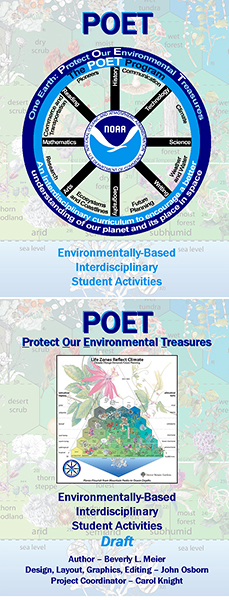Earth Systems Research Laboratory - Global Systems Division: Outreach/Education
POET - Environmentally-Based Interdisciplinary Student Activites

Education - The POET Program Educational Activities
Using science as a foundation, The POET Program - Protect Our Environmental Treasures - provides a series of activities to interrelate various subjects that students learn in school and gain an insight into how these subjects can be used in “real life” situations while practicing “thinking” and “reasoning” (brain tools) skills that all students need for success as a student and in adult life. For most of the POET activities, each lesson has five parts.
- At the beginning there is...
- a problem question (inquiry) to be answered as a result of the investigation so that students clearly understand what is expected;
- a category that names the interdisciplinary subjects of study that are emphasized in the lesson;
- a connection to the real world that identifies how the lesson is used in real life;
- an opportunity to identify prior knowledge, a technique that helps to set the stage for the lesson. Students write what they know about a topic before the lesson. After the lesson, they add what they have learned; and
- background information to encourage reading and discussion.
- An activity (the investigation) is designed to actively engage students in the learning process.
- Questions (analysis) lead students toward a more complete understanding of each activity. The questions are arranged in order of difficulty with the intent of challenging each student to an individual “best”.
- A conclusion helps students to demonstrate new knowledge by integrating the various parts of the lesson in a short essay.
- Compare and contrast prior knowledge with the conclusion. Students can easily see improvement.
POET topics were chosen so that students are exposed to trend setting scientific research as they practice the processes of science – learning basic concepts and principles, posing a question to be investigated, collecting data, graphing, analyzing, and predicting – all in an interdisciplinary setting.
For teachers, POET was designed to be self-contained with little extra effort beyond gathering materials. The lessons are versatile enough to adapt to different teaching styles and can be used in either small group, large group, or individual instruction. Although created for middle and high school, students in upper elementary school could benefit by doing parts of each lesson. The questions that accompany the activities are graduated in difficulty. By design, easier questions are at the beginning followed by more difficult questions toward the end of the question section. The POET activities conform to the National Science Education Content Standards.
Interview with author Beverly L. Meier
(transcript here)
For further information, please send e-mail correspondence to poet.esrl@noaa.gov.
POET Program Activities
*the following links are all PDF files
- Preliminary Information (Cover, Title Page, Table of Contents, Introduction, Goals, Structure, Acknowledgements, Standards)
- Five Section Title Pages
- Section 1 - Modeling Earth
- Activity 1 - Nighttime Lights of the World
- Activity 2 - Using Different Models of Earth
- Activity 3 - Topography and Bathymetry
- Activity 4 - The U.S. Coast and Geodetic Survey to the Rescue
- Section 2 - Weather
- Activity 5 - Tornado Over Kansas
- Activity 6 - Hurricanes (Three Parts)
- Part 1 - Environmental Satellites
- Part 2 - Creating a Satellite Image Using Pixels
- Part 3 - A Cross-Section Through the "Eye" of a Hurricane
- Activity 7 - Winter at the South Pole
- Section 3 - Global Warming
- Activity 8 - Carbon Dioxide and Seasons
- Activity 9 - Global Warming
- Activity 10 - Arctic Sea Ice
- Section 4 - The Carbon Cycle
- Activity 11 - How It Works
- Activity 12 - CarbonTracker
- Activity 13 - The Annual Greenhouse Gas Index
- Activity 14 - Students Help to Control Their Carbon Footprint
- Section 5 - Planning for the Future
- Answer Keys and Conclusions for all Activities
- Additional Information on the POET Program

